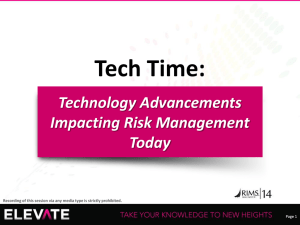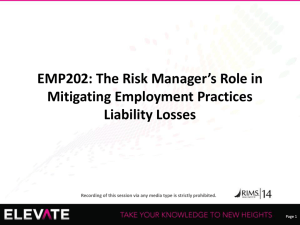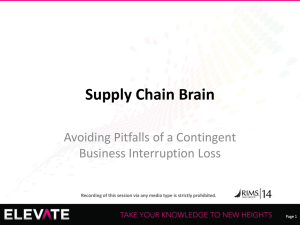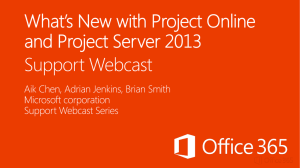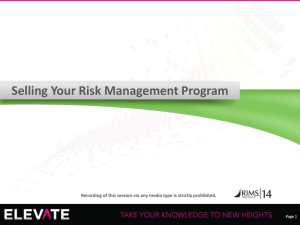Why Plan?
advertisement
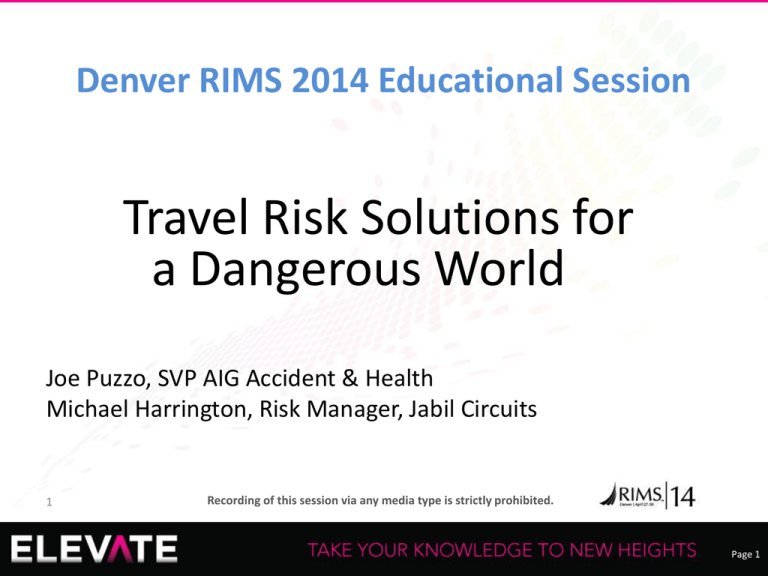
Denver RIMS 2014 Educational Session Travel Risk Solutions for a Dangerous World Joe Puzzo, SVP AIG Accident & Health Michael Harrington, Risk Manager, Jabil Circuits 1 Recording of this session via any media type is strictly prohibited. Page 1 • Joe Puzzo, SVP Business Development, AIG Accident & Health - 40 year Industry Veteran/24 with AIG - Focus on Travel protection for Employer & Participant Groups - Fairfield University (BA History), American College (CLU & ChFC ). • Michael Harrington, Senior Director Risk Management and Attorney, Jabil Circuits - Prior Roles; Risk Manager for Textron and EMC - Retired Major from 10th Special Forces Group (Airborne) - Norwich University (BA History), Harvard (MA Government), Boston (JD Law) Recording of this session via any media type is strictly prohibited. Page 2 What to Expect • Understand potential exposure. • What are the key considerations? • Risk Mitigation Planning: a real time example. Recording of this session via any media type is strictly prohibited. Page 3 Why Worry? • Travel increases vulnerabilities in a risky world • Political, environmental, cultural, technical unknowns • Crime and corruption • Health and safety laws • Duty of Care – issues facing the Risk Manager 4 Recording of this session via any media type is strictly prohibited. Page 4 Why Plan? Obtaining medical treatment and hospital care abroad can be expensive, and medical evacuation to the United States can cost more than $50,000.1 Workers who travel more than 20 nights a month were 2.61 times more likely to report they were in poor or fair health than those on the road one to six days a month.2 Seventy-nine adverse incidents of violence involving U.S. citizens and interests abroad occurred in 2011; seventy-eight are believed to have resulted from intentional targeting of Americans.3 Only 86 percent of 2011 U.S. domestic flights departed on time; nearly two in 100 were canceled.4 Recording of this session via any media type is strictly prohibited. Page 5 The Reality of Today’s Travel Environment • • • One in eight U.S. adults (12%) either had their travel impacted, or considered changing their travel plans, due to natural disasters or world events since summer 2010; less than 30% of impacted travelers had travel insurance.1 In 2012, 98 incidents of political violence that occurred abroad involved U.S. citizens and interests; 91 are believed to have resulted from intentional targeting of Americans.2 A 2012 survey also revealed that 18 - 34 year olds were most likely to have their travel plans impacted by natural or other world events, followed by college graduates (17%) and parents of children under 18 years of age (16%). 1 • • • • Obtaining medical treatment and hospital care abroad can be expensive, and a medical evacuation to the United States can easily exceed $10,000 or more depending on the patient’s condition and location.3 The average cost of a nurse escort from a European location is $24,000.4 Passengers filed approx 1.78 million mishandled baggage reports with the largest U.S. air carriers in 2012.5 On-time flight performance has decreased; only 80% of U.S. domestic flights departed on time over the last 2 years, a 6% decrease since 2011.6 Recording of this session via any media type is strictly prohibited. Page 6 Duty of Care – What and Why? A requirement that a corporation act toward employees and the public with watchfulness, attention, caution and prudence that a reasonable person in the circumstances would. If a corporation’s actions do not meet this standard of care, then the acts could be considered negligent, and any damages resulting may be claimed for negligence. Employers have a duty to protect their employees while traveling and an obligation for the health, safety and security of their employees. 7 Recording of this session via any media type is strictly prohibited. Page 7 Impact of Legislation • Employers’ duty and obligation for traveling employees • Defining your “Duty of Care” • Consequences if you don’t fulfill your obligation 8 86% of corporate travelers believe their firm has a legal obligation to support them abroad Over 50% would consider taking legal action in the event of an emergency being mishandled Recording of this session via any media type is strictly prohibited. Page 8 The Solution is Best Practice Flexible and Realistic • • • • • • • Understand potential liabilities and risks Ensure 24/7 assistance services Establish procedures for incident handling Mandate training Monitor world events Establish communication channels Utilize technology to locate employees 9 38% of travelers said they never do any research on the country they visit 78% said they never carry an emergency phone number Recording of this session via any media type is strictly prohibited. Page 9 EXPECT THE UNEXPECTED MEDICAL ASSISTANCE, REPATRIATION, SECURITY 10 Recording of this session via any media type is strictly prohibited. Page 10 Global Assistance Services • • • • • • 11 Medical Security Pre-Trip Planning Physicians/Dental Referrals Medical Payment Assistance Repatriation of Mortal Remains Recording of this session via any media type is strictly prohibited. Page 11 Pre-Trip Planning • • • • • 12 Physicians Consultation Immunizations Prescription Medications Contact Numbers Research the Destination Recording of this session via any media type is strictly prohibited. Page 12 Behind the Scenes of an Evacuation Gather Information Monitor and Communicate Determine the Need Plan Logistics 13 Recording of this session via any media type is strictly prohibited. Page 13 Gather Information Information is critical to assessment and success. • • • • • • • • Name and local contact information Synopsis of current situation Medical and/or police reports Travel information (dates, location) Medical contacts (local & home) Date of birth, passport & Visa Travel companion(s) and their demographics Language needs (client, family, local medical provider) 14 Recording of this session via any media type is strictly prohibited. Page 14 Determine the Need Engage Assistance company for best resolution Medical team gives a professional assessment: • Review case and medical report • Speak with local, treating physician • Determine adequacy of medical facility, evacuation methods and travel recommendations • Language Skills • Closest appropriate medical facility versus home 15 Recording of this session via any media type is strictly prohibited. Page 15 Plan the Logistics TIMING METHOD Acuity Location Time of Day Security Commercial Stretcher Ambulance 16 Recording of this session via any media type is strictly prohibited. Page 16 Monitor & Communicate • • • • • • Identify home physician/hospital Secure hospital admission Review insurance information Update family/employer/medical providers Contingency plans Close loop at final destination 17 Recording of this session via any media type is strictly prohibited. Page 17 Manage Your Security From a Distance 18 Recording of this session via any media type is strictly prohibited. Page 18 Global View Travel Risk • Crime, Political Unrest, Terrorism, Natural Disasters, Culture • 41 countries with Travel Alerts and Warnings* • Hot Topics: Syria, Brazil, Egypt Terrorist Attacks/Civil Unrest Terrorist Attacks/Civil Unrest Athens Athens Columbia Columbia Denmark Denmark Dubai Dubai Ireland Ireland Namibia Namibia 19 Ottawa Ottawa Pakistan Pakistan Russia Russia Spain Spain Turkey Turkey Nigeria Nigeria Recording of this session via any media type is strictly prohibited. Page 19 How Do You Manage Risk? • Anticipate/analyze/report • Create a global system of crisis response & management • Train and prepare your employees • Maintain an effective network of global response capabilities • Setup your firm’s ability to Assess global risk and ability to respond o Communicate globally o Locate, assist, and recover personnel o 20 Recording of this session via any media type is strictly prohibited. Page 20 Critical Elements for Preparation • • • • • • • • “Planning is bringing the future Increased awareness into the present so you can do Destination briefs something about it now.” Intelligence reports – Alan Lakein Travel updates Single point-of-contact for emergencies Redundant communications Crisis management/response structure Travel tracking mechanism 21 Recording of this session via any media type is strictly prohibited. Page 21 Threat Assessment • Socio-economic awareness • Impact of Political, Ethnic, Racial, Religious, or Tribal Relationships • Health • Law Enforcement Capabilities • Criminal Activity • Potential for K&R or Terrorist Attacks • Identify Location “Hot Spots” • Weather 22 Case Study: EGYPT • Overnight transformation • Vacation destination, business hub • Civil unrest • Arson attacks • Security forces • Breakdown in law and order • Border and ports of entry all closed • Europeans attacked and arrested Recording of this session via any media type is strictly prohibited. Page 22 Vulnerabilities • Arriving at new locations o • • • • Airports, Railway Stations, Hotels Transportation Unrest (riots or large crowds) Criminal activity Assistance expectations (Law Enforcement/Medical/Gov’t) • Food/beverage consumption • Communication limitations 23 EXAMPLES United States: Boston Marathon Bombing Algeria: Terror attack at the Tigantourine Gas Facility Colombia: Employee robbed at gunpoint Recording of this session via any media type is strictly prohibited. Page 23 Security Summary Recognize Potential Dangers • • • • • • • • Maintain/instill high level of Personal Awareness Know before you go (research cultures/customs, etc) Vary routines and avoid certain locations Present a hard target Keep a low profile but project confidence Understand communication abilities/limitations Know your crisis management plan Practice/update policies and emergency plans frequently 24 Recording of this session via any media type is strictly prohibited. Page 24 A Risk Management Perspective Michael E. Harrington Global Senior Director of Risk Management Jabil Circuit 25 Recording of this session via any media type is strictly prohibited. Page 25 Jabil Circuit Has a Global Footprint 26 Recording of this session via any media type is strictly prohibited. Page 26 Jabil Circuit Has a Global Footprint • Global Manufacturing Provider • 23 Million Manufacturing Sq Ft. • 60 Sites on Four Continents • 151,000 Dedicated Employees • 153,804 Travel Days • 15,788 Individual Employee Trips Global Electronics Solutions For a Changing World 27 Recording of this session via any media type is strictly prohibited. Page 27 Jabil’s Blue Chip Customer Base Diversified Manufacturing Services 28 Enterprise & Infrastructure High Velocity Recording of this session via any media type is strictly prohibited. Page 28 Jabil’s Challenge About 150,000 global employees Remote work locations • Metal Grinding • Hot Plastic Extrusion • Melted Metal Applications Expats, Local Nationals, 3rd Country Nationals & Contractors 40 countries of operations 29 Dangerous work – high potential for injury Traditionally dangerous countries • Security issues • Weather extremes • Poor access to medical care • Poor local infrastructure Over 153,000 Travel Days between more than 200 Countries Recording of this session via any media type is strictly prohibited. Page 29 The Risk Management Perspective Setting the Scene – Think Global and Act Local Compliance/Legal, Tax, and Regulatory Key Questions: • How do you know your program is compliant from a Tax and Regulatory standpoint? • How do you fulfill admitted insurance needs globally? • How do you effect claims payments outside of the US in the local country, in the local currency? • How do you deal with Transfer Pricing – Kvaerner Case and other issues • Local Expertise: Brokers and Insurers • Ease of Doing Business for Operational Business Unit – Business wants to focus on core activities – Business does not want the extra duty of insurance placement or compliance 30 Recording of this session via any media type is strictly prohibited. Page 30 The Risk Management Perspective Structural Considerations • Where is the company located, and where does it conduct business? Admitted Jurisdictions – India, Brazil, etc o Non-Admitted Jurisdictions (keep an eye on taxes) – Canada, UK, Singapore, etc o Hybrid Jurisdictions – Germany, Italy, etc (for professional lines) o What insurance is required locally? o What personal liability risks exists? (BTA, Side A D&O) o Duty of Care for all Employees 31 Recording of this session via any media type is strictly prohibited. Page 31 Institute Corporate Travel Policy Starting Point – Travel Policy 32 Clearly outline parameters Forbidden countries (extreme risk) Restricted countries (very high risk) • Prior approval from Executive Committee • Only with approved security/transportation arrangements • Approved modes of travel – Restriction of commercial airlines in some African nations – Charters (prior approval required) • Aggregation of employees on planes – Max total per conveyance – Max number of Board/Executive Committee members • Clear approval process for exceptions to policy – Head of business – Executive Committee Recording of this session via any media type is strictly prohibited. Page 32 Communication Keep it simple! One membership card for all Employees Globally 33 Recording of this session via any media type is strictly prohibited. Page 33 Service Providers Insurance Partner - Business Travel Accident (BTA) Coverage • Out of country medical expense coverage • Medical evacuation/repatriation • Understand what policy covers • What does evacuation mean? • Accidental death & dismemberment coverage • Travel concierge services Security firm (can come packaged with BTA) • Security advise/support • Security evacuations • Travel intelligence Kidnap & Ransom Insurance (K&R) • Insurance coverage • Specialist consulting for employee recovery • Incidents need to be handled differently Create Service Protocol for vendors 34 Recording of this session via any media type is strictly prohibited. Page 34 Lessons Learned No such thing as enough training! Close working relationships are key (internal/external) Pre-planning will help to work the bugs out Learn from each incident No two incidents are alike 35 Recording of this session via any media type is strictly prohibited. Page 35 A Plan that is Strategic Risk Mitigation Is: • Deliberate and thoughtful • With a focused, documented plan • With protocols and review points Done Correctly It Is: • 3 Rights: Care/Response, Time, Location • Mitigates corporate exposures 36 Recording of this session via any media type is strictly prohibited. Page 36 THANKS FOR YOUR TIME Questions? 37 Recording of this session via any media type is strictly prohibited. Page 37
